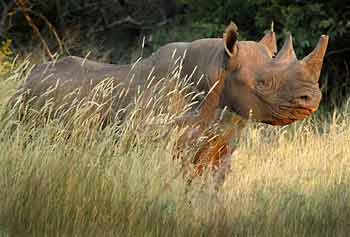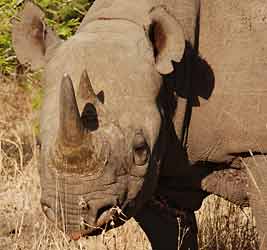Contact Details: Scotch Macaskill, Dirt Road Traders, Currys Post Road, Howick, KwaZulu-Natal, South Africa. Tel: +27 (0)82 578 2329. Privacy: Your privacy is guaranteed. See our Privacy Policy for more. This site accepts advertising and other forms of compensation - see Disclosure and Advertising for details. Site updated: 2022. Copyright © 2002 - 2022 Scotch Macaskill

| ||||||||||
|
||||||||||
|
See also info about: |
Black Rhino Information
Note: The Rhino Information provided here applies specifically to the critically-endangered black rhinoceros, which is much less common and hence less frequently seen on safari than its counterpart, the larger and more placid white rhinoceros. Appearance:
As is the case with the white rhino, the name "black rhino" is not related to the color of the animal's hide. The hide is in fact a dark gray color with lighter underparts and, like the white rhino, what you see is dependant on the color of the dust or mud in which it wallows. The skin is as thick as 1.5 cm in places to protect the rhino against sharp grasses, plants and thorns. The black rhino has two horns on the front of its face, with the front horn being longer. The tail is relatively short with a tuft of coarse hair at the tip. Unlike the white rhino, the black rhino has no hump on its back and keeps its head in an upright position. Another major difference is the characteristic pointed or hooked upper lip which is prehensile - like a finger - and is suited to browsing the leaves and twigs off of trees (compared to the square lip of the white rhino which is suited to grazing grasses). Behavior: The black rhino is a solitary animal except during mating season, or when calves need to be raised. The bulls are aggressive and often charge the moment they suspect trouble. This is because of their poor vision. They are notoriously bad tempered, and are surprisingly fast and agile. They can reach speeds of up to 45km an hour. Black rhinos do not fight over territories like their white counterparts, but instead they fight for a receptive cow. In the heat of the day, black rhinos take refuge in dense thickets. They feed in the early mornings and late afternoons. The dung, in comparison to the white rhino, is made-up of twigs and other coarse material which they ingest while browsing. Rhinos in general have very poor eyesight, and depend heavily on their acute sense of smell and hearing to recognise potential danger. Reproduction: The black rhino has no fixed breeding season, and has only a single calf, which weighs up to 40 kg after a gestation period of 450 days (15 months). The calf either walks next to the mother or behind, which is opposite to the white rhino where the calf walks in front of the mother. The calf can walk and feed three hours after birth, and stays with its mother for two to four years until it is chased away to fend for itself.
Diet:
Sounds:
Status:
For additional facts about the black or hook-lipped rhino, see WWF Black Rhinoceros Info. Return to Wildlife Info . |
|||||||||
|
|
||||||||||

 Black rhino showing distinctive hooked lip
Black rhino showing distinctive hooked lip